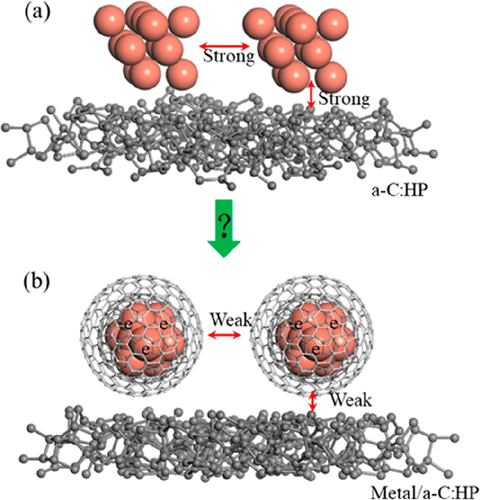Abstract
Presently, approaches to achieve superlubricity for diamond-like carbon (DLC) films rely heavily on the film deposition techniques and parameters, such as other nonmetallic element incorporation and structure optimization. In this work, we report a new feasible pathway to achieve superlubricity for DLC films, which is not dependent on the film preparation parameters but rather on the external effects, i.e., sliding interfacial addition of metal nanoparticles (Cu and Ni). The approach controls the structures of wear products by the introduction of metal nanoparticles and the subsequent effect of metal catalysts, to in situ form graphene-coated particles without impacting the overall performances of the films. Through detailed experimental investigations combined with density functional theory (DFT) simulations, graphitic encapsulation and electronic shielding of metal nanoparticles are responsible for the dramatic changes at the frictional interface leading to metal-carbon interfacial superlubricity. We expect that the approach will enrich the understanding of the lubrication mechanism of DLC films and promote the DLC films' superlubricity toward applications.
Presently, approaches to achieve superlubricity for diamond-like carbon (DLC) films rely heavily on the film deposition techniques and parameters, such as other nonmetallic element incorporation and structure optimization. In this work, we report a new feasible pathway to achieve superlubricity for DLC films, which is not dependent on the film preparation parameters but rather on the external effects, i.e., sliding interfacial addition of metal nanoparticles (Cu and Ni). The approach controls the structures of wear products by the introduction of metal nanoparticles and the subsequent effect of metal catalysts, to in situ form graphene-coated particles without impacting the overall performances of the films. Through detailed experimental investigations combined with density functional theory (DFT) simulations, graphitic encapsulation and electronic shielding of metal nanoparticles are responsible for the dramatic changes at the frictional interface leading to metal-carbon interfacial superlubricity. We expect that the approach will enrich the understanding of the lubrication mechanism of DLC films and promote the DLC films' superlubricity toward applications.

KeyWords Plus:TRIBOLOGICAL PROPERTIES; AMORPHOUS-CARBON; EELS ANALYSIS; DIAMOND; FILMS; FRICTION; GROWTH; ORIGIN; WEAR; DLC
Published in ACS APPLIED MATERIALS & INTERFACES,Volume 13;10.1021/acsami.0c18900,JAN 20 2021


